
Nephrolepis exaltata, known as the sword fern or Boston fern, is a species of fern in the family Lomariopsidaceae. It is native to the Americas. This evergreen plant can reach as high as 40–90 centimetres (16–35 in), and in extreme cases up to 1.5 metres. It is also known as the Boston swordfern, wild Boston fern, Boston Blue Bell Fern, tuber ladder fern, or fishbone fern.

Alsophila dregei, synonym Cyathea dregei, is a widespread species of tree fern in southern Africa.

Polystichum acrostichoides, commonly denominated Christmas fern, is a perennial, evergreen fern native to eastern North America, from Nova Scotia west to Minnesota and south to Florida and eastern Texas. It is one of the most common ferns in eastern North America, being found in moist and shady habitats in woodlands, stream banks and rocky slopes. The common name derives from the evergreen fronds, which are often still green at Christmas.
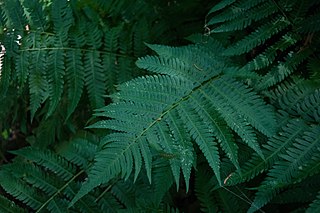
Dryopteris goldieana, commonly called Goldie's wood fern, or giant wood fern is a fern native to the eastern United States and adjacent areas of Canada, from New Brunswick to Ontario and Georgia. It is the largest native North American species of Dryopteris and along with ostrich fern it is one of the largest ferns in eastern North America. Specimens are known with fronds six feet tall. D. goldieana hybridizes with many other species of Dryopteris and the hybrids tend to be larger than the pure species. It was named by William Hooker in honor of its discoverer, John Goldie. The epithet was originally published as goldiana, but this is regarded as a misspelling to be corrected.
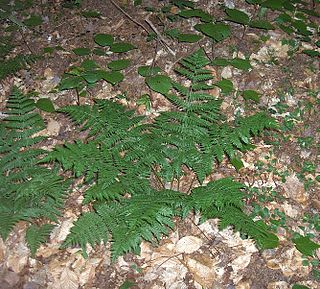
Dryopteris intermedia, the intermediate wood fern or evergreen wood fern, is a perennial, evergreen wood fern native to eastern North America. It is a diploid species, and is the parent of several species of hybrid origin, including Dryopteris carthusiana. Other common names for this species include intermediate shield fern, fancy wood fern, fancy fern, glandular wood fern, American shield fern and common wood fern.

Amauropelta noveboracensis, the New York fern, is a perennial species of fern found throughout the eastern United States and Canada, from Louisiana to Newfoundland, but most concentrated within Appalachia and the Atlantic Northeast. New York ferns often forms spreading colonies within the forests they inhabit.
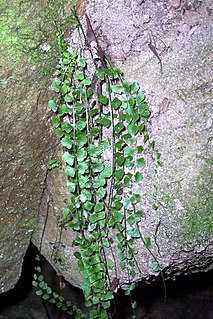
Asplenium flabellifolium is commonly known as the necklace fern. This small fern occurs in all states of Australia, as well as in New Zealand. It was initially described by Spanish botanist Antonio José Cavanilles.
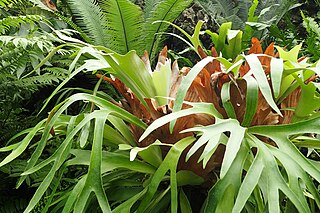
Platycerium bifurcatum, the elkhorn fern or common staghorn fern, is a species of fern native to Java, New Guinea and eastern Australia, in New South Wales, Queensland and on Lord Howe Island. It is a bracket epiphyte occurring in and near rainforests. Growing to 90 cm (35 in) tall by 80 cm (31 in) broad, it has heart-shaped sterile fronds 12–45 cm (5–18 in) long, and arching grey-green fertile fronds which are forked and strap-shaped, and grow up to 90 cm (35 in) long.
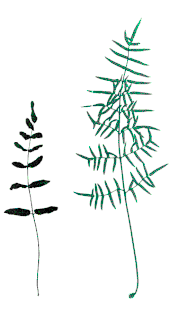
Pellaea atropurpurea, commonly known as purple-stem cliffbrake or just purple cliffbrake, is a fern native to North and Central America. Brake is an old word for fern, related to the word bracken. Like many other members of the Pteridaceae, it is a rock plant, needing a calcareous substrate.

Pellaea truncata is a species of fern known by the common name spiny cliffbrake. It is native to the southwestern United States and northern Mexico, where it grows in rocky areas, such as cliffs and slopes.

Pellaea calidirupium, the hot rock fern, is a fern of eastern Australia and New Zealand restricted to rocky areas in relatively arid environments. In Tasmania, where it is considered rare, it is only found on the East Coast, the Midlands, and lower slopes of the Central Plateau on dry rock faces. It is also found in Victoria and Queensland. The species was originally described from New Zealand.

Polystichum lonchitis is a species of fern known by the common name northern hollyfern, or simply holly-fern. It is native to much of the Northern Hemisphere from Eurasia to Alaska to Greenland and south into mountainous central North America. It has stiff, glossy green, erect fronds and grows in moist, shady, rocky mountain habitats.

Pellaea rotundifolia, the button fern, is a species of fern endemic to New Zealand, where it grows in scrub and forests. It is also a popular garden plant and house plant, tolerating low temperatures but not freezing.

Histiopteris incisa, the bat's wing fern, water fern or fern mata, is a common plant found in Australia, New Zealand and other islands in the south Pacific region. Usually found in moist areas, where it may form large colonies. The lowermost lobes of each pinnae have a bat wing like appearance, giving the fern its common name.
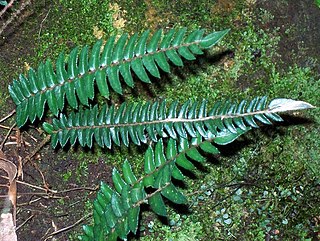
Pellaea nana, known as dwarf sickle fern, is a fern species in the subfamily Cheilanthoideae of the family Pteridaceae. It grows in eastern Australia, in rainforest or moist eucalyptus forest, often on rocks, cliffs and large boulders. Also found growing on Lord Howe Island. The original specimen was collected by Allan Cunningham at the Brisbane River. In the state of Victoria, this plant is considered rare. The specific epithet nana is derived from the Latin word nanus meaning dwarf.

Adiantum viridimontanum, commonly known as Green Mountain maidenhair fern, is a rare fern found only in outcrops of serpentine rock in New England and Eastern Canada. The leaf blade is cut into finger-like segments, themselves once-divided, which are borne on the outer side of a curved, dark, glossy rachis. These finger-like segments are not individual leaves, but parts of a single compound leaf. The "fingers" may be drooping or erect, depending on whether the individual fern grows in shade or sunlight. Spores are borne under false indusia at the edge of the subdivisions of the leaf, a characteristic unique to the genus Adiantum.

Myriopteris alabamensis, the Alabama lip fern, is a moderately-sized fern of the United States and Mexico, a member of the family Pteridaceae. Unlike many members of its genus, its leaves have a few hairs on upper and lower surfaces, or lack them entirely. One of the cheilanthoid ferns, it was usually classified in the genus Cheilanthes as Cheilanthes alabamensis until 2013, when the genus Myriopteris was again recognized as separate from Cheilanthes. It typically grows in shade on limestone outcrops.
Myriopteris allosuroides is a moderately-sized fern of Mexico, a member of the family Pteridaceae. Unlike many members of its genus, its rachides are grooved on the upper surface and largely free of hairs or scales. One of the cheilanthoid ferns, it was usually classified in the genera Cheilanthes or Pellaea until 2013, when the genus Myriopteris was again recognized as separate from Cheilanthes. It typically grows on dry, rocky slopes over acidic, particularly basaltic, rock.
Argyrochosma connectens is a small cheilanthoid fern endemic to Sichuan, China. It is the only member of its genus known from Asia. Relatively rare, it is found growing in the crevices of limestone rocks in hot, dry valleys. The species was long classified in the genus Pellaea, but after a phylogenetic study in 2015 was transferred to Argyrochosma.

Myriopteris rawsonii, formerly known as Cheilanthes rawsonii, is a perennial fern native to Namaqualand.


















